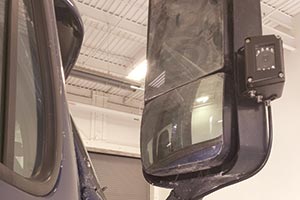Managing Editor, Features and Multimedia
Trucking Industry’s Onboard Video Market Expands to Multicamera Deployments

This story appears in the Oct. 31 print edition of Transport Topics.
Trucking’s onboard video market is expanding beyond cab cameras to capture a more complete view of what is happening around the vehicle.
Suppliers offer an array of cameras around the truck — including side and backup cameras — to help fleets monitor their operations, provide enhanced liability protection and make it easier for drivers to operate safely.
Lytx Inc., the industry’s largest supplier of video-based safety technology, recently launched its Unisyn platform, which can enable fleets to install and connect a virtually limitless number of cameras on the truck.
“I think people are just starting to get a sense of the power of video in running transportation companies,” Lytx CEO Brandon Nixon said.
Lytx is best known for its DriveCam program, which uses a two-way camera to capture video of the driver and the road ahead during triggered events to support driver coaching.
But the Unisyn platform uses video in a very different way by focusing instead on enhancing the efficiency of fleet operations.
In another recent development, PeopleNet introduced side cameras to its video-intelligence product line to complement its existing cab cameras.
The left and right cameras, which are situated on the truck’s spot mirrors, move the company closer to its goal of providing 360-degree “surround vision.”
SmartDrive Systems, meanwhile, gives fleets the option to deploy up to four cameras with its Assurance 360 platform. That offering, first announced two years ago, can incorporate side and backup cameras into the system.
New England food distributor Bozzuto’s Inc. has been outfitting its trucks with side cameras to provide additional liability protection in the event of crashes involving the trailer.
“That’s always a gray area when it comes to motor vehicle accidents,” said Tom Halpin, transportation safety manager at Bozzuto’s.
Historically, those types of accidents often have boiled down to one person’s word against another’s, he said, but the side cameras record both sides of the trailer to show which vehicle actually drifted out of its lane. That video can exonerate the truck driver, or at least provide the fleet with a true picture of what happened.
“There’s no more guesswork,” Halpin said.
The side cameras are part of a multicamera deployment from SmartDrive that includes a cab camera to record the driver and the road ahead when triggered by a critical driving event, such as a crash or hard braking.
“When I see a video now, I see a four-screen view instead of two,” Halpin said, adding that the idea for the side cameras originated with the company’s drivers.
Bozzuto’s has rolled out the side cameras on about 50 of its 260 trucks and plans to deploy the system across its entire fleet.
The Cheshire, Connecticut-based company also uses a few portable backup cameras from Convoy Technologies as a training tool for its less experienced drivers. The cameras send a video feed to an in-cab monitor to help those drivers learn how to back up properly and avoid minor accidents at delivery locations.
“We go into a lot of tight stores and spots,” Halpin said. “Usually, that’s where a green driver gets himself in trouble.”
SmartDrive’s side cameras typically are installed on the mirror or the back of the cab and pointed down the side of the trailer — views that a forward-facing camera would not capture.
“There are a lot of collisions back there,” said Jason Palmer, the company’s president.
Additional cameras can serve as a tool for workers’ compensation purposes by tracking how drivers are loading or unloading a trailer to prevent injuries.
Melissa Purcell, vice president of marketing, said some flatbed fleets are mounting a camera on top of the truck and pointing it down at the bed of the trailer. Fleets can then check and see if drivers are tarping their loads correctly and wearing the proper protective gear.
Lytx’s Unisyn platform allows carriers to implement “always on” video and apply it to a host of business problems, ranging from tracking driver dwell time at loading docks to ensuring cargo security.
“The number of applications is almost unending,” Nixon said while introducing the platform at American Trucking Associations’ annual Management Conference & Exhibition in Las Vegas in early October.
With Unisyn, fleets can customize a network of cameras wirelessly connected through Wi-Fi and Bluetooth. They also can configure ways to “tag” their video to organize it and use it efficiently.
“We see a massive hole in the marketplace where clients really want to use video as the center of transforming their businesses,” Nixon said.
Some of the possibilities include cameras on the side or back of trailers, inside the trailer to monitor cargo or even installed on a loading dock.
Lytx customers can use Unisyn in conjunction with or independent of DriveCam.
The most compelling return on investment for video is lia- bility protection, said Jim Angel, vice president of video intelligence solutions at PeopleNet.
“We all know we operate in a very litigious environment,” he said.
The costs of truck-crash settlements and judgments are on the rise, and some legal firms are spending much of their time going after truck collisions, even though the majority of those accidents are the fault of the car driver, he said.
“It’s the next ambulance-chaser business,” Angel said. “Without video, you don’t have a method to really protect yourself.”
The left and right cameras help expand that liability protection to side crashes.
Citing data from the National Highway Traffic Safety Administration, Angel said 24% of truck and car collisions are same- direction lane incidents.
PeopleNet also is using its side cameras to expand drivers’ field of vision.
“We have the ability, when the driver turns on his right-hand blinker, to bring that blind spot into the view on our existing display,” Angel said.
That capability currently is available on PeopleNet’s ConnectedFleet Tablet.
Looking ahead, PeopleNet plans to introduce a backup camera for trailers and straight trucks. That product is in testing, Angel said.
Another telematics provider, Omnitracs, recently launched an onboard video system of its own.
That product currently is limited to a cab camera, but the company said it designed the system in a way that could accommodate additional video feeds from side or backup cameras in potential future releases.
Sales of and interest in backup cameras have been rising steadily, said James Grossbaum, director of marketing at Rear View Safety. “It’s getting more and more mainstream.”
However, adoption has been slower in trucking compared with some other industries, such as recreational vehicles. That’s because there is still a lot of resistance from some drivers, particularly experienced ones who are proud of their driving abilities, Grossbaum said.
Nonetheless, onboard cameras can help carriers prevent accidents and keep insurance costs down, he said. “They really are a no-brainer on vehicles, especially in the commercial industry.”




